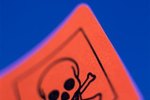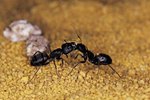
The woodlouse spider, also called the woodlouse hunter, is a hairless spider generally found in states such as Georgia and California. Commonly mistaken for the deadly brown recluse spider, the woodlouse spider's bite is not life-threatening. Knowing where to find woodlouses and how to identify them can help prevent potential spider bites.
Woodlouse Venom
A woodlouse spider's venom is secreted from two large fangs that project from its body. Pillbugs are usually the receiver of this venom as woodlouses feed almost exclusively on the small insects. However, woodlouses that come into contact with people can sometimes bite humans. These bites can be painful due to the spider's massive fangs, but they are not known to require medical attention. People who have been bitten by woodlouses report that the bite is intensely itchy.
Woodlouse Habitat
Woodlouse spiders are commonly found in gardens, under rocks or in the shade of logs. They are night dwellers and catch their prey after the sun goes down. Warm weather and high humidity can sometimes lead to woodlouses finding their way inside houses. Homeowners have been known to find these arachnids in their basements. The spiders are not known to be aggressive and will not usually bite unless scared or provoked.
Woodlouse Identifiers
Woodlouse spiders are commonly mistaken for the brown recluse spider because of their similar shapes. But woodlouses have distinguishing characteristics including a reddish-brown head and a cream-colored abdomen. The spider's legs are orange. Woodlouse spiders can grow to about a half inch in size. The spider's fangs are large and thick and protrude forward. Unlike most spiders, the woodlouse has only six eyes, which are arranged in an oval shape.
Allergic Reactions
While a woodlouse spider's venom does not usually cause serious harm to humans, it is possible for bite victims to suffer allergic reactions due to the injury. People with compromised immune systems or other medical conditions may also experience more serious reactions to such spider bites. The Mayo Clinic recommends seeking medical attention if a spider bite is severely painful or the victim experiences abdominal cramping. A growing ulcer at the bite site is another reason for a doctor's visit.
.
References
- Penn State College of Agricultural Sciences: Spider: The Woodlouse Hunter
- The Ohio State University Extension: Sowbug Killer Spider
- University of Minnesota Extension: Common Spidersin and around Homes
- Penn State College of Agricultural Sciences: Spiders Commonly Encountered In Pennsylvania and the Northeast
- Mayo Clinic: Spider Bites
Resources
Photo Credits
-
Thinkstock/Comstock/Getty Images
Writer Bio
Alicia Gallegos is a journalist in northwestern Indiana. She previously wrote for the "American Medical News, "a Chicago-based health newspaper published by the American Medical Association. She began her career at the South Bend Tribune, where she covered public safety, courts, food safety, education and health care.



